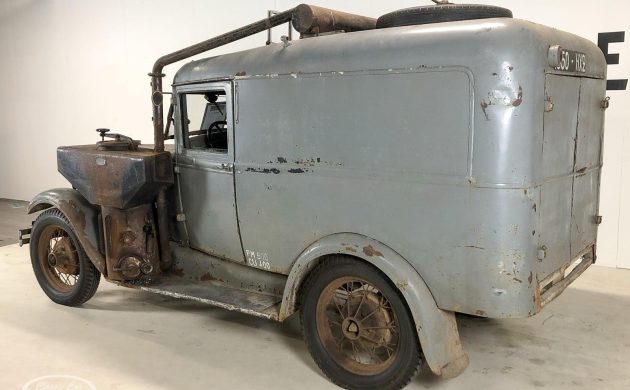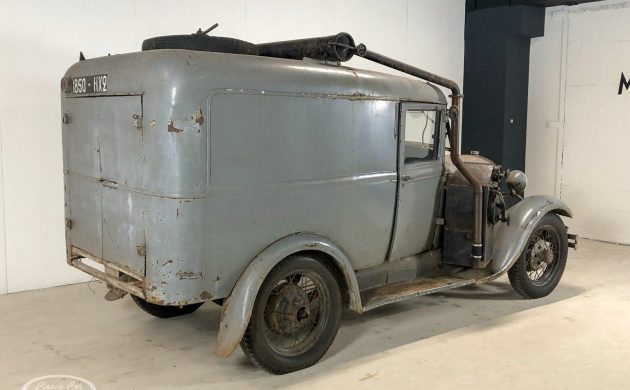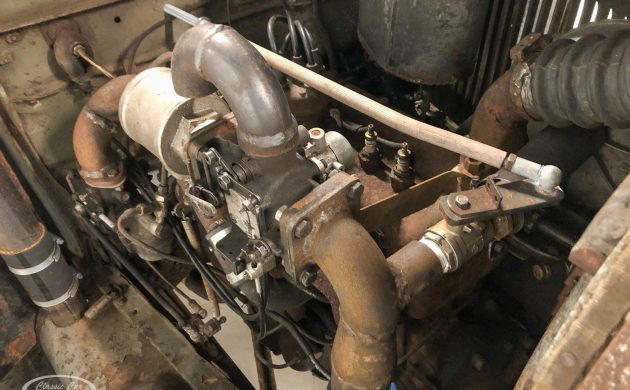On June 22, 1940, the unthinkable happened to the people of France. It was on that date that the French government under Marshal Henri Petain signed an armistice with Adolph Hitler and Nazi Germany. Before long over half of France was under the direct control of German forces, and for French citizens there was little to do but try to survive until Allied armies eventually crossed the Rhine River in March 1945. With a war in their homeland, simple tasks became difficult or impossible at times. One of those activities was securing fuel. With any available gasoline being used in the war, resourceful people managed to power their cars with alternative energy sources. One of the more popular was a coal gas conversion as you see attached to this 1931 Ford Model A.
The panel van you see in this ad is listed by the auction house as a 1932 model. Before the comments fill with angry statements about how there is no such thing as a 1932 Model A Ford, Ford had a factory in Asnieres-sur-Seine, France. This is a suburb of Paris, and the factory was engaged in the production of Model A Fords in the early 1930s. There is documentation showing that they switched over to a V-8 powered car identical to the stateside Ford in 1932 along with producing an 8-horsepower car more befitting European standards. Chances are the last Model A produced in France was in 1931 and the auction made a mistake with the model year. However, if any of our readers know if Model A production in France stretched into 1932, please let us know in the comments. You would think that the French factory would continue to produce the Model A until the new V-8 was established in the United States.
Once you get past the Ford Model A’s origins, the most interesting thing about this vehicle is the fuel system. This article in Hemmings explains how France went through a period where there were many attempts to make a useful gasifier system that used wood in the 1920s. Weight, complexity, and the thirst for wood that the devices exhibited eventually drove investors and interested parties away from this technology. Finding a fuel that works better than gasoline is difficult, then and now. A gallon of gasoline has a tremendous amount of potential energy, is easy to transport, and is convenient to find and purchase. In the end, it is all about BTUs and ease of storage.
Yet when that gasoline is unattainable, the alternatives look attractive. That was the case when France got entangled in yet another World War. While gasification systems were popular in the 1920s, their development had come to a halt not long after for the larger companies with a few smaller operations still producing these kits into the 1930s. There were also a large number of older cars and trucks with the system still around when the war started. It wasn’t long before these vehicles were either pressed back into daily service or their gasification systems were retrofitted to newer vehicles. As crude and slow as vehicles so equipped appeared, at least their owners were able to stay moving during a dark time in France’s history.
The vehicle you see here uses the gasification process to propel it along. In the ad, it is also claimed to run on gasoline, petroleum (kerosene?), and coal. Given coal’s higher BTUs for the same weight of fuel should have allowed for having to carry less fuel and it should have been easier to handle and use than wood. We are told that the conversion was installed in 1940 and it still works. Despite the run-down appearance of the vehicle, it is claimed that it runs and drives well. The ad correctly points out that nearly all of those conversions were taken off after hostilities ceased. Finding one that works is a challenge, but locating one in what appears to be its World War II-era condition is a feat bordering on miraculous. Hopefully, it will be displayed frequently by the new owner. A vehicle like this one is a reminder of both the sacrifices of war and the determination and ingenuity of humanity during tough times.
While the auction concluded on June 18 in the Netherlands, the photographs and a brief description of this highly unusual Model A Ford are still available on the Classic Car Auctions website. According to the website, the final bid was 6,250 Euros plus a 15.13% auction fee.













This gives “Rollin’ Coal” a whole new meaning
Ha! Good one. In case that went over some heads, the term “rolling coal” is a trucking term when trucks blast that annoying cloud of smoke in your face. I thought originally had to be a RR term, but research shows, before diesel fuel, was used, coal dust was tried. It was deemed too unpredictable, and diesel was used.
About 3 weeks ago I saw one of these. I am old enough to have seen the original TV show Combat! But for some reason didn’t. In our area, there are 2 reruns on Saturday night. Combat! is a high-quality program in terms of realistic weapons etc. I like to watch if I can.
This episode happened at night. Old French guy helping with a truck that looked like this one. In every scene I noticed a little fire burning on the side of the old French guy’s truck.
Must have been one in California then.
Combat! Season 2, Episode 14
Best view at 18 minutes
Thunder from the hill 1963.
But this had an actual purpose other than to show that the driver is a moron!
Very interesting ! I had never heard of that !
I am glad I read this article.
Heated wood or coal gives off a combustible gas, same thing done all over Europe, and in U.S. during W.W. 2. Also known as producers gas or wood gas.
considering todays gas prices,can i install this on my 2006 F-150 ROUSH….LOL
Fascinating find! I would like to know more about how this actually functions.
Not that it matters…but for those of us here who are Model A Ford people — this is NOT a 1931 Ford Model A. Without being able to see this car in person, this is either a 1928 or 1929.
Certainly not all original. Those are modern mandrel bent U shaped pipes.
This one needs to be bought and paraded near the next Save The Earth protest/rally/crying towel session. This would really make a stink!
If that’s what floats your boat.
Sure does! Not your cup of milk, eh?
Why?
Very cool. The price seems like a bargain. Maybe this was built in 1931 or 1932 but it’s definitely a 1928 or 1929 model year here in the states.
I agree. Even though it has been heavily modified, everything I see makes it a 28 or a 29. Definitely not a 30 or 31. It may have been modified then, but based on an earlier production vehicle.
I remember my father, who served in the U.S. Army infantry in Europe in WWII, telling me about seeing coal-fueled vehicles there, probably in France and/or Germany. He wasn’t a mechanic or anything approaching that, so I was left imagining cars and trucks burning chunks of coal for propulsion, but this write-up enlightens how this technology really worked.
I’ve only seen this conversion on Citroen Traction Avant’s; this has got to be rarer then hen’s teeth! Awesome find!!
As for the date, it looks like the last inspection sticker on the license plate is 1850.
Charcoal was widely used as fuel.
In France this was called a “gazogène”, a wood gasifier.
In a similar vein, back in the late sixties or early seventies, Hot Rod magazine ran an article about a guy who put a wood stove in a trailer behind his Chevelle wagon and ran the smokestack from the stove up to the engine compartment and drove the thing across the country on wood smoke. It certainly wasn’t practical but it was doable.
During the war also in switzerland many vehicles were equipped with this kind of technology, even heavy trucks
About 3 weeks ago I saw one of these. I am old enough to have seen the original TV show Combat! But for some reason didn’t. In our area, there are 2 reruns on Saturday night. Combat! is a high-quality program in terms of realistic weapons etc. I like to watch if I can.
This episode happened at night. Old French guy helping with a truck that looked like this one. In every scene I noticed a little fire burning on the side of the old French guy’s truck.
Must have been one in California then.
Combat! Season 2, Episode 14
Thunder from the hill 1963.
Attention Kaiser Fraser fans.Auto Parts City minutes ago took in a 51′ or so Traveler,this a yard where they crush vehicles. Video on their site of it being g brought in.
I think such engines were started on gasoline and once the engine was warm then switched over to charcoal gas. The process was similar for kerosene fueled tractors.
Cool…..or would that be hot…..glad it survived !
In the 1930s this system was widely used in the colonies for heavy trucks.
My father was in the Battle of the Bulge and said those French trucks were so low powered when they came to an incline everyone but the driver would jump out and start pushing.
A informative write up. I really like this car and the price was reasonable.
A property I own has a large wood gasifier on it. I believe it was part of an off grid experiment. It is very large upright boiler, perhaps 8 feet long and 4′ in diameter. If I understand correctly, it also condensed the gas back into a liquid to be combusted. It is very heavy, as it is steel and lined with firebrick.
A scaled down version on a car like this must have very limited ability to produce gas, perhaps a couple of HP worth. I can see where storage and weight of material would be a problem. But still probably better than walking. I’m surprised you didn’t se them on tractors and anything is better than plowing with a horse.
A lot of years back (close to 50), The Mother Earth News did an article about a gasification project. What I can remember of it was they took a “used” General Motors pick up with a V-8 engine topped with a Quadrajet carburetor. The two sides of the carb were isolated so one side was used for gasoline and the other half was used to regulate the wood smoke being burned as a motor fuel. A guy from around the area I grew up in said when he was station in Germany with the Army, he was driving on the Autobahn and was passed buy a truck burning wood smoke as its fuel.